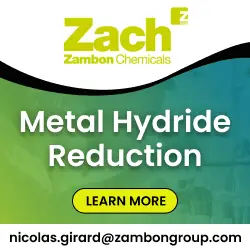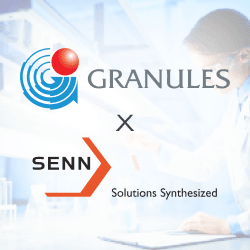Overview of selective reductions of aldehydes, ketones, etc. with metal hydrides, including Lithium Aluminum Hydride, NABH4 & other reducing agents.
Q1. What are metal hydrides?
Metal hydrides constitute a class of chemical entities in which hydrogen is chemically bonded to a metallic center. A hydride is any class of chemical compounds in which a hydrogen is combined with another element. Transition metals and inner transition metals form a large variety of compounds with hydrogen. Metal-hydrogen bonds, also known as metal hydrides, are ubiquitous X-type ligands in organometallic chemistry.
Generally, the bond is covalent in nature, but some hydrides are formed from ionic bonds. The most common examples of metal hydrides include aluminum, boron, lithium borohydride, lithium aluminium chloride, lithium aluminum hydride-aluminum chloride and various other salts. These metal hydride reducing agents are suitable for various uses.
Metal hydrides play an important role as reducing agents (e.g. LiH, NaH, LiAlH4, LiBH4, lithium aluminum hydride-aluminum chloride) and are widely used for catalysis. They are not only synthetically useful but are extremely important in custom synthesis and manufacturing of pharmaceutical intermediates in a number of catalytic cycles and also in battery technologies.
Transition metal hydrides are key pharmaceutical intermediates in reactions such as homogeneous hydrogenation, hydroformylation, hydrometallation and transfer hydrogenation. The reactivity of the transition metal hydrides depends on the properties of the metal and auxiliary ligand. Metal hydrides have also been the most commercially successful hydrogen storage materials.
Q2. What are the different types of metal hydrides?
Metallic hydrides are formed by heating hydrogen gas with metals or their alloys. Based on their structures, metal hydrides can be divided into four classes. The most common hydride are those that form with hydrogen, dubbed binary metal hydrides. Other types of metal hydrides are less known, including ternary metal hydrides, coordination complexes, and cluster hydrides.
Structure-wise classification:
Binary hydrides (e.g. CaH2, Aluminum Hydride): Metal hydrides are binary compounds if they are made of one type of metal and hydrogen. Although hydrides can be formed with almost all main-group elements, the number and combination of possible compounds varies widely; for example, there are over 100 binary borane hydrides known, but only one binary aluminium hydride.
Ternary hydrides (e.g. Lithium Aluminum Hydride, NaBH4): Metal hydrides made of two different metals and hydrogen are known as ternary hydrides. Because of their high lattice energy, these salts are typically not soluble in any solvents.
Coordination complexes (e.g. Tris(triphenylphosphine)rhodium carbonyl hydride, Decacarbonyldihydridotriosmium). The most prevalent hydrides of the transition metals are metal complexes that contain a mix of other ligands in addition to hydrides. Some industrially useful hydrides may function as catalysts for hydroformylation reactions.
Cluster hydrides (e.g. Decacarbonyldihydridotriosmium): In this class, the H atom can be found in a cluster molecule as either a terminal or bridging H atom. Moreover, there may be more than one H atom bonded to the same metal centre in what is called a non-classical hydride.
Q3. What are the steps involved in complex metal hydride reduction?
Complex metal hydride reduction:
Reduction reactions can be defined as conversion of an atom in a higher oxidation stage to a lower one. Reduction with complex metal hydrides are the most widely used reduction reactions, followed by catalytic hydrogenation. The most common metal hydride reducing agents are lithium aluminium hydride (LiAlH4), sodium borohydride (NaBH4) , lithium aluminum hydride-aluminum chloride, etc.
-
Reduction with complex metal hydrides (metal hydride reduction) most commonly utilizes LiAlH4 and NaBH4 as reducing agents. In the process of reduction with complex metal hydrides, (1) NaBH4 is one of the most widely used metal hydride reducing agents. It is stable to moisture and air and used in industrial applications.
-
(2) LiAlH4 is a strong metal hydride reducing agent which is widely used in reduction with metal hydrides and is capable of reducing ketones, aldehydes, and even carboxylic acids and esters into alcohols. It can reduce nitriles and amides to amines and also reacts with organic halides and sulfonates to displace them with hydrides.
Aldehydes and ketones are reduced to alcohols with either lithium aluminum hydride, LiAlH4, or sodium borohydride, NaBH4. These reactions result in the net addition of the elements of H2 across the C=O bond. Lithium aluminum hydride is by far the most reactive of the two compounds, reacting violently with water, alcohols and other acidic groups with the evolution of hydrogen gas.
Steps involved in complex metal hydride reductions of aldehydes and ketones:
Step 1: Nucleophilic attack by the hydride anion
The nucleophilic H in the hydride reagent adds to the electrophilic C in the polar carbonyl group, electrons from the C=O move to the O creating an intermediate metal alkoxide complex.
Step 2: Protonation of alkoxide
This is the work-up step, a simple acid/base reaction. Protonation of the alkoxide oxygen creates the primary alcohol product from the intermediate complex.
The mechanism for a NaBH4 selective reduction and a LiAlH4 selective reduction (reduction with metal hydrides) is the same except methanol and ethanol are the proton sources used in the second step, respectively.
Selective reduction of carboxylic acids and esters:
In the process of reduction with metal hydrides, carboxylic acids and esters can be converted to 1o alcohols using LiAlH4, while sodium borohydride (NaBH4) is not a strong enough reducing agent to perform this reaction. In carboxylic acid reductions, an aldehyde is produced as an intermediate during the reaction, but it cannot be isolated because it is more reactive than the original carboxylic acid.
Q4. Who are the different service providers offering metal hydride reduction services?
Pharmaceutical service providers offering metal hydride reduction services include:
Zach System
Zach provides custom API synthesis and manufacturing services for Active Pharmaceutical Ingredients (API) & quality intermediates involving metal hydride reduction services with reducing agents including LAH, DIBAL, LiAl (O-tBu)3H, NaBH4, etc.
Innovassynth Technologies
Innovassynth deals in nucleoside & non-nucleoside chemistry with expertise in scale up from research to pilot & commercial manufacturing, aided by metal hydride reduction services.
Sreepathi Pharmaceuticals Ltd
Sreepathi Pharmaceuticals offers metal hydride reductionreactions. Their manufacturing facility is WHO GMP certified and is equipped to handle complex manufacturing processes and chemical reactions.
All Suppliers












 Zach System is committed to providing Highly Customized Solutions for all your Development Programs.
Zach System is committed to providing Highly Customized Solutions for all your Development Programs.







